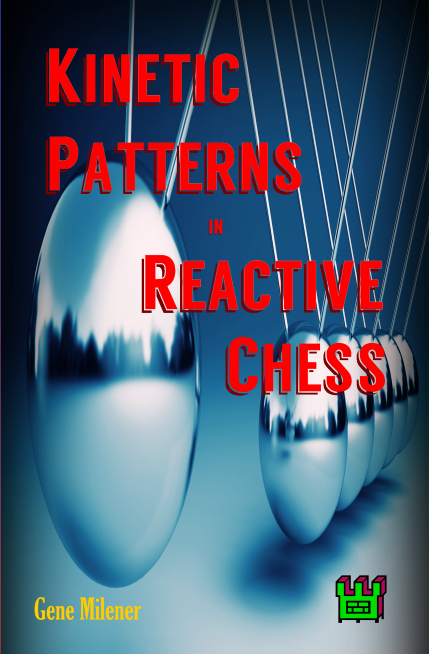

Kinetic Patterns in Reactive Chess (KPiRC)
published July 2018
ISBN-10: 0977452115
ISBN-13: 978-0977452118
Review, 2018/November/01:
Kinetic Patterns in Reactive Chess is a very interesting chess book written about the intuitive command of repeated kinetic patterns.
Going through this book will help you develop a kinetics based algorithm for identifying and understanding chess patterns.
Personally I think that players such as Magnus Carlsen have a natural born talent for chess patterns.
In ChessBase we could read:
"If 'pattern' is understood as 'piece configuration', acquisition of chess skills appears even more cumbersome, depending on how fast one can set up different positions either on a board or on a computer screen. On average, with 10 learned a day, it takes 27 years to acquire 100,000 patterns which, in turn, makes it hard to explain how young super-GMs, like Magnus Carlsen (GM at 13, learning chess at age 8, means 20,000 patterns a year and 55 patterns a day), at such a tender age can be much stronger than older GMs having had much more time to acquire far more patterns. Or, are we talking about different GMs being familiar with different sets of patterns reflected in the rating differences?"
- Rune Vik-Hansen
- July 20, 2018
- https://chessbase.com/post/pattern-recognition-fact-or-fiction
Our author claims that shot puzzles with kinetic info are easier to remember than without, and that makes a lot of sense.
This and more are excellently explained by the brilliant chess philosopher and software engineer Gene Milener, who wrote in 2006 the best selling work Play Stronger Chess by Examining Chess960.
Fascinating to mention is chapter 24 with the subject Underwhelmed by Overlearning. Here Milener discusses the works from several other chess contributions as from, Adriaan de Groot, who tested in the past chess positions on very strong players as Paul Keres and Alekander Alekhine!
By the way Gene Milener, his references to other works in this book is more than impressive!
Some players claim that memorization of whole chess games helps you to internalise useful patterns for the long term but our author does not (*1) agree, simply try this book and I can asure you, that your play will improve!
Conclusion: This is super reading!
( *1 footnote, Gene Milener replies with a small correction:
I DO recommend the memorization of whole grandmaster games. I argue that the fastest and easiest way to memorize a whole chess game is to understand and use the kinetic reactive perspective. Also, kinetic reactivity explains why some moves are harder to remember than others. See chapter 24/C.10, near its end.)
The above review was taken from the following link, and was then lightly edited:
http://chessbooks.nl/elburg246.html
Introduction: What is this Book About? PART A: DOGMA, PARADOX, MYTH, AND ILLUSION 1 / A.1 Philosophical Landscape +14 2 / A.2 Analysis Stuck in Static +8 3 / A.3 Traditional Shot Puzzles Reject Kinetics +14 4 / A.4 Calculation Inflation +14 5 / A.5 The Blunder Continuum +18 PART B: KINETIC ATOMICS 6 / B.1 Concepts of Kinetic Chess: KAC and KAR +10 7 / B.2 Timbals Cataloging for KAC +18 8 / B.3 Timbals /S Cataloging +10 9 / B.4 Timbals KAC Exercises +6 10 / B.5 Concept of Reactive Chess for KAR +12 11 / B.6 BCM: Best Consecutive Move +12 12 / B.7 BCM and Chess Style +7 13 / B.8 Proactive is Illusion +13 14 / B.9 Kinetic Views of the Initiative +17 PART C: IMPLICATIONS OF KINETICS 15 / C.1 Don't Just Tell Me Where Waldo Is +10 16 / C.2 Human Factors in Kinetic Atomics +4 17 / C.3 Kinetic Skills Must Precede Calculation Skills +11 18 / C.4 Asequential Calculation: All KAR, then All KAC +7 19 / C.5 Can You Evaluate After Calculation? +8 20 / C.6 KAP: Kinetic Atomic Patterns +17 21 / C.7 Can Biased Data Justify Unbiased Eyes? +10 22 / C.8 Forcing as Observed in the Wild +11 23 / C.9 Kinetic Shot Puzzles +7 24 / C.10 Underwhelmed by Overlearning +35 25 / D.1 GRAND SUMMARY OF KPiRC +11 PART E: SIDE TRIPS ALONG THE JOURNEY 26 / E.1 Draw Problem +16 27 / E.2 MWCC: One More White +13 28 / E.3 Font: Chess Handy Symmato 3D +19 29 / E.4 Chess960-FRC Epilogue +16 30 / E.5 XSAN: Motivations +10 31 / E.6 XSAN: Syntax +10 32 / E.7 XSAN: Discussion +9 33 / E.8 Glossary of KPiRC +5 Cover: Covers of KPiRC Explained (End of ToC.) 428 pages
Interested in 'Fischer Random Chess', also known as 'chess9LX' and 'chess960'? Then you may be interested in our other book...
Play Stronger Chess by Examining Chess960 .
.